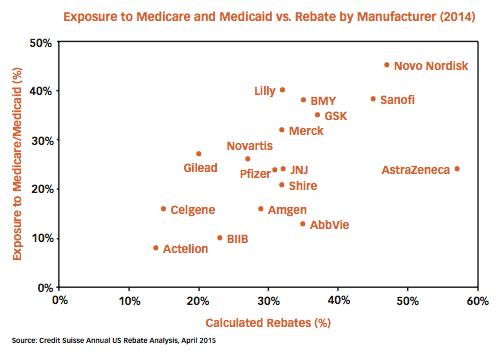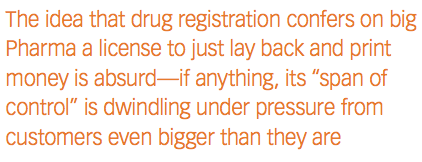Competition: The Best Defense
Pharmaceutical Executive
A new and more compelling strategy must be crafted to engage critics on drug pricing and bolster biopharmaceuticals as a leader in technological innovations that lower health costs overall.
BIOPHARMACEUTICALS ARE A BUSINESS WITH A SIMPLE MISSION: to compete within the margins set by science to invest and develop medicines that prove useful to patients. How
William Looney

successful the business is in doing so determines the rate of return on that investment to shareholders, in the form of revenues and profits. These are, in turn, the basic driver of “value,” an always fuzzy metric that has lately morphed from an equally simple measure-market relevance-to a messier, more fluid construct linked to reputation in serving the public trust. And this is where that simple business mission gets increasingly complicated-because price negotiations assign not only a financial but a social value to the transaction.
It’s the old public good argument, but with a special twist in that a dominant purchaser seeks to capture the dispersed societal payoff of a new drug innovation, in the form of a low price. Inherent in this debate about defining value is a larger question: is the act of creating a new drug so morally transcendent and socially satisfying it should be done just for the love of it? Financial Times economist Tim Harford concludes, “that may be fine for pop songs and poetry but less so for an HIV vaccine. Costly R&D programs will not be funded.”
Some observers contend that this standard industry-supported argument-innovation carries a stiff price-is irrelevant now that many cancer drugs cost two or even three times the annual income of the average American family. A new, more compelling strategy must be crafted to engage critics on pricing and bolster biopharmaceuticals as a leader in technological innovations that lower health costs overall.
There is a larger, neglected defense that could help deflect the slide in public support. No improvisation is required to state it, because it is parcel of the industry’s daily bread: In a grossly complex and dysfunctional healthcare system, biopharmaceuticals are a business that works-and the proof that counts is competition.
Call it competition
Examples are numerous. The average period of market exclusivity, during which a new drug has no challenger in its therapeutic category, has dwindled to a matter of months from the two-to -three-year average just a decade ago. Net pricing is pervasive in contracting between drug manufacturers and the three remaining pharmacy benefit managers (PBMs), which means that these market-power purchasers receive rebates averaging about 40% of the publicly quoted retail price for listed drugs. There is also the standard “price protection” contract clause that drugmakers must sign to get their drug placed on a PBM formulary, in return for which they guarantee any price increase during the life of the contract will be passed back to the PBM in the form of additional rebates.
The idea that drug registration confers on big Pharma a license to just lay back and print money is absurd-if anything, its “span of control” is dwindling under pressure from customers even bigger than they are. A graph analysis (from Jo Walton of Credit Suisse) below shows how the market drives products that are least novel into paying steep discounts-companies with many novel products pay least.

In this climate, there is no chance for an offense, just a good defense. As one company executive tells Pharm Exec, “we can’t afford to have 30 or 40 or 50 million lives not under contract, regardless of whether the HMOs and employer groups under the PBM can actually live up to the formulary terms and incentives included in the signed agreement.”
And navigating through this customer maze is getting harder still. Big Pharma has to be big because you need the stamina to jump at least three hurdles before your drug reaches a single patient. It starts with the PBM, whose benefit model is focused on keeping the “per-member per-year” cost of drugs as low as possible; continues to provider-run integrated delivery networks (IDNs), which set the clinical pathways that drive prescribing and incentivize outcomes; and ends with the patient, whose actions are influenced by higher insurance plan deductibles and co-pays-will the patient actually pay for that scrip or just walk away?
The deductible trap
The truth is drugmakers are running and competing hard within a complicated, multi-layered, pass-through-pharmacy financing chain. A report just released by the IMS Institute for Healthcare Informatics-co-authored by Pharm Exec Editorial Advisory Board member Mason Tenaglia-tracks how deductibles on commercial plan enrollee drug benefits are becoming a

common feature in health plan design: the report finds the percentage of plans with a drug deductible has spiked from 23% to 46% since 2012. For branded drugs, 9% of all commercially insured transactions in 2014 were passed on to the patient at full price. The implications of this trend include lower utilization of necessary medicines due to patient abandonment, fewer choices for prescribers, and higher health plan costs for downstream services like emergency room visits.
While the patient is a clear loser here, it is likely to be painful for drugmakers, too. Insurers’ passing the buck for drug costs to enrollees in an era of zero real growth in personal income will only put more pressure on volume sales for marketed drugs, with possible residual effect on prices and margins.
Does this emerging reality mean the only option is to move toward a government-negotiated system of price controls on medicine? No, because there is evidence that industry competition, private commercial administration, and public financing can work together to manage drug costs, without a bureaucratized, interventionist approach to spending.
Need proof? It’s called Medicare Part D. By and large, Part D plans are administered by three large private insurers-United Healthcare, CVS, and Humana-which gives them the scale to obtain real value for money from the Centers for Medicare & Medicaid Services (CMS) while preserving patient choice. Analyses by the Congressional Budget Office (CBO) indicate their performance record on cost and patient responsiveness is better than either the employer commercial plans or government programs like Medicaid and the VA/DoD. As Express Scripts chief medical officer Steve Miller has noted, it means that after rebates, purchasers in the US now pay less than Europe for those hep C cures.
Imagine: government and private enterprise working together to keep value upmost in mind. It’s the power of two combined for the one that counts-the patient.
William Looney is Editor-in-Chief of Pharm Exec. He can be reached at wlooney@advanstar.com. Follow Bill on Twitter: @BillPharmExec

Trump: 'Major Tariff' on Pharmaceuticals Coming Soon
Published: April 9th 2025 | Updated: April 9th 2025“We’re going to tariff our pharmaceuticals, and once we do that, they are going to come rushing back into our country," President Donald J. Trump said during a Tuesday night dinner in Washington.